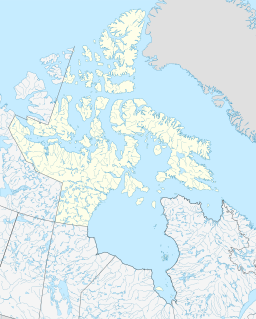Ethnography
Hanningajuq is the Inuktitut word for both Garry Lake and the Christian cross. [4] Garry Lake was historically home to Inuit who refer to themselves as Hanningajurmiut or Hanningaruqmiut or Hanningajulinmiut, meaning "the people of the place that lies across". Inuit to the north (the Utkusiksalinmiut) refer to Garry Lake Inuit as Ualininmiut ("people from the area of which the sun follows east to west"). The Garry Lake Inuktitut dialect is related to Utkuhiksalik, the dialect of the Utkuhiksalingmiut. Like other Caribou Inuit, Hanningajurmiut life consisted of tracking Arctic wildlife—Beverly herd of the barren-ground caribou, [6] and fishing (whitefish and lake trout). [7] They lived in igloos in the winter months, and caribou skin tents in the summer months.
Between 1948 and 1955, Hanningajurmiut were able to trade at Kitikmeot fur trader Stephen Angulalik's outpost located at Atanikittuq ("little connection") at Sherman Inlet. [8] A Roman Catholic mission post was established on an island in Garry Lake in 1949, staffed by Father Joseph Buliard, who disappeared in 1956. The cabin still stands in present day. [9] [10] Suffering from famine in 1958 as the annual caribou migration bypassed their territorial hunting grounds, 58 Garry Lake inhabitants died. The federal government intervened by relocating the 31 survivors to Baker Lake. Most Hanningajurmiut never returned to Garry Lake on a permanent basis. [4] [11] [12] [13] [14] [15]
William Noah, Community Liaison Officer for Areva Resources Canada in Nunavut toured around Garry Lake on August 11, 2009, along with Paul Atuutuva, Betsy Aksawnee, Silas Kenalugak, and David Aksawnee. The pilot was with Forest Helicopters, working on contract for Kiggavik camp for Areva Resources Uranium Camp, 80 km (50 mi) west of Baker Lake. They found a bag and some small items that were still fresh in the attic of the old Buliard mission.
This page is based on this
Wikipedia article Text is available under the
CC BY-SA 4.0 license; additional terms may apply.
Images, videos and audio are available under their respective licenses.

